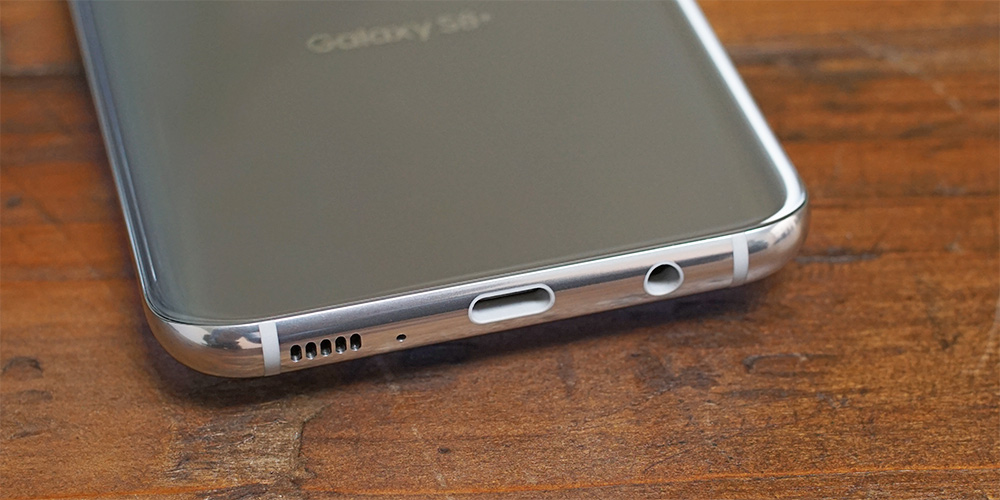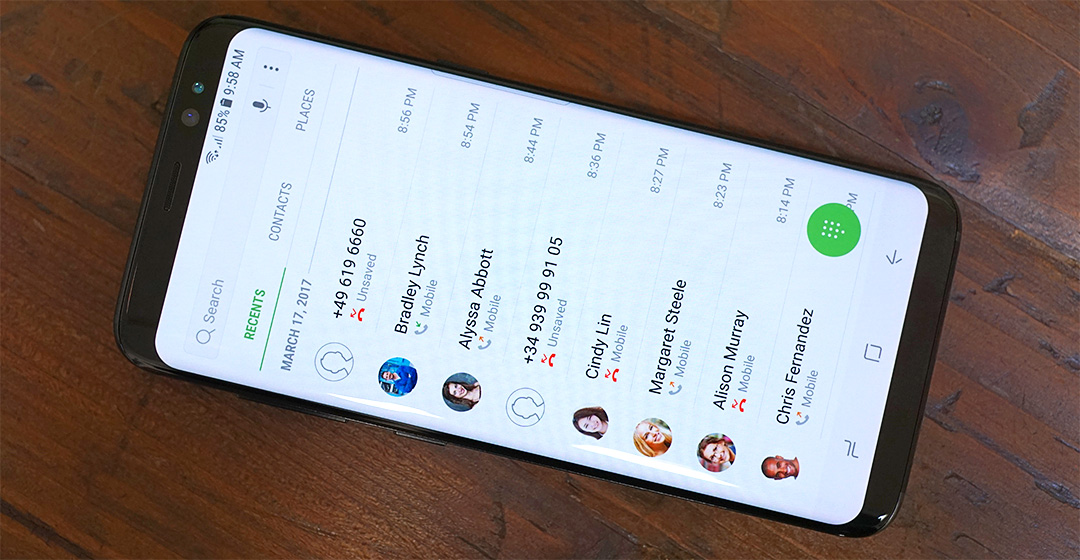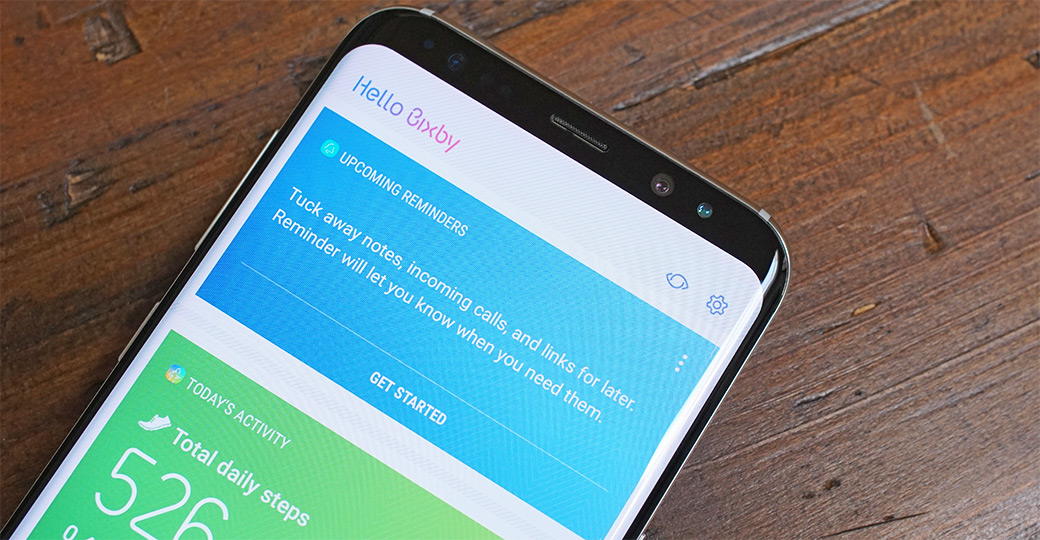Hands On With Samsung's Galaxy S8 and S8+: Taller Screens and Slimmer Bezels
by Matt Humrick on March 29, 2017 11:00 AM EST- Posted in
- Smartphones
- Samsung
- Galaxy
- Mobile
- Galaxy S8

Samsung officially unveiled the latest Galaxy devices at its Unpacked event in New York today. Previous Galaxy phones were part Porsche 911 Carrera, with an easily recognizable curvaceous style, and part Swiss Army knife, bristling with technology and features. This analogy holds true for the 5.8-inch Galaxy S8 and 6.2-inch Galaxy S8+, which share the same design DNA as the previous two generations.
The new phones’ aluminum frame remains sandwiched between edge-to-edge Corning Gorilla Glass 5, with curved sides on the front and back. The curved rear glass makes the phones easier to pick up and more comfortable to hold just as they did for the S7 and S7 edge, while the curved front glass—now standard on both S8 models—adds some visual flair.
There’s not much difference between the S8 and S7 along the sides either. The USB Type-C port on the bottom is flanked by a 3.5mm headphone jack and a single downward-firing speaker. The microSD/NanoSIM combo tray still resides on the top, and the thin power button is still a bit more than halfway up the right side. The only differences between new and old lie on the left side, where the volume buttons have been combined into a single rocker and a dedicated button for launching Samsung’s Bixby assistant makes its debut. Unlike the power button, I found myself occasionally pressing the Bixby button accidentally when picking up the smaller S8.
The most significant change is found up front, however, and it’s one that impacts both form and function. The Galaxy S8 and S8+ adopt Samsung’s new “Infinity Display” that stretches the screen vertically but not horizontally, deviating from the traditional 16:9 aspect ratio. The result is a QHD+ SAMOLED display with a 2960x1440 resolution and an 18.5:9 aspect ratio that’s very similar to the 18:9 aspect ratio display LG is using in its G6. Both Samsung and LG cite market research for this new display direction: People want larger screens that can show more content, but they also want phones that are useable with one hand and can fit in their pocket. The taller screen fits more content, so less scrolling, but keeps the phone narrow, so it’s easier to wrap your hand around.
Both S8 phones incorporate another emerging design trend: rounded display corners. Where LG’s G6 is using an LCD panel that actually has rounded corners, it appears Samsung is using a rounded bezel to cover the S8’s still sharp-cornered display. This avoids the aliasing that’s evident in the G6’s corners, producing a much smoother, nicer looking effect. While my time with the S8 was limited, it appears that TouchWiz and Samsung’s apps were redesigned to account for the rounded corners: Backgrounds extend the full height of the display and visual elements are still displayed along the top and bottom edges without getting cut off. Third-party apps, however, find their vertical dimensions constrained to the purely rectangular portion of the display, with the status bar above and the navigation bar below taking on black backgrounds.
The S8 and S8+ are also the first phones to receive the UHD Alliance’s Mobile HDR Premium certification that ensures a mobile device meets the minimum requirements for playback of 4K HDR video. This means that both S8s are capable of rendering at least 90% of the DCI-P3 color gamut, have a dynamic range of at least 0.0005-540 nits, and support a 10-bit display pipeline.
To keep the overall size of the phones in check, the S8/S8+ and G6 have dramatically reduced the bezel area around the taller screens. Samsung claims a screen-to-body ratio of 83% for its new Galaxy phones, less than the 91.3% of Xiaomi’s Mi MIX concept phone, but impressive nonetheless, especially considering how much hardware is located in the S8’s upper bezel. Besides the usual earpiece and proximity/ambient light sensors, there’s a new 8MP front-facing camera with f/1.7 lens and Smart AF that uses facial recognition for accurate focusing when taking selfies. There’s also an IR LED and IR camera for the iris-scanning security feature that made its debut on the ill-fated Galaxy Note7.
Shrinking the size of the lower bezel required relocating the fingerprint sensor to the back. Instead of placing it below the rear camera like we see on most other phones, Samsung places it next to the flush-mounted camera, which is less than ideal. Both the camera and the sensor are surrounded by a raised lip and are similar in size, making it difficult to locate the sensor by feel, and if your finger misses the sensor, you end up with a nice fingerprint on the camera lens. On the smaller S8, this issue may be mitigated with practice, but the problem is worse for the S8+. Being taller, it places the camera and sensor further from the lower edge, making it very difficult, if not impossible, to reach the sensor when holding the phone with a natural grip. Even with my larger-than-average hands, I struggled to reach the sensor without shifting my grip. I suspect people will turn to the iris scanner or the new face unlock feature, which uses the front camera for facial recognition after pressing the power button, to overcome the poor fingerprint sensor placement. The physical home button and capacitive navigation buttons, iconic Galaxy design features, have also been evicted in favor of the slimmer bezel, replaced by onscreen controls.



















208 Comments
View All Comments
arayoflight - Wednesday, March 29, 2017 - link
Audio will be nice I guess. All the exynos models always had the wolfson DAC. Qualcomm versions traditionally blow though. Storage space is plenty with the 64GB base option with microSD slot.It's a pass for me too, with that mediocre battery capacity and the same camera. But the rest of the phone looks awesome. UFS 2.1 storage too seems nice.
more-or-less - Wednesday, March 29, 2017 - link
Who the 'eck needs dual cam? Do you see professional grade camera or any cameras using dual sensor? Just because apple shoved up your arse doesn't mean everyone wants a dual cam. A good single sensor is way better than crappy dual sensor. Idiots like you rest of humans look dumb as fuck.osxandwindows - Wednesday, March 29, 2017 - link
So, how's the pay?halcyon - Wednesday, March 29, 2017 - link
I've used Mate9 with dual camera and it's really nice. And superior in zoom, in b/w photography and also excellent in low-light if you use manual mode.Further, Huawei already ships 128GB and 256GB internal flash models along with microsd-card slot. I can easily max out the 64GB on my phone (and I already have a 256GB sdcard).
Yes, I'm a power user. Go ahead, sue me :-D
lilmoe - Wednesday, March 29, 2017 - link
hmmmm. The phone is pretty darn impressive though, and will most probably be the best in 2017 until the Note8 is announced. The crap load of leaks took too much of the excitement away, since we already knew everything about it.About the specs....
- Processor: This is as good as it will get this year for the SoC. I don't believe anything better will come out, definitely not from Apple at least (might be contempt with fixing their cluster migration issues and go HMT).
- Screen is the absolute best. AMOLED+ is back. Hope to see better upscaling of lower resolution presets.
- Build is stunning.
- Radio stack should be the best in the business.
- Software and hardware processing improvements in the camera, probably same sensor (still best in class).
- We still have no information about the speaker and DAC. Seemed much loader and fuller from what I've heard from the DaX demo. Will have to see reviews and test it in hand.
- Battery life needs to be tested.
- User interface is awesome.
- I wouldn't call Bixby a work in progress. I believe they totally nailed what I want from voice interaction. Very nice.
Would I upgrade? Most probably not (unless I find a massive discount by the end of the year). Pretty sure most of the software improvements and Bixby will find its way to my Exynos GS7, which is already better than anything out there especially after the Nougat update (including the G6 from LG). I mostly use my camera in manual mode anyway (lowest ISO possible) which takes photos much, MUCH better than anything out there.
I would have been more enticed to upgrade if:
- the processor had an improved little cluster (efficiency cores). I was hoping they'd have swapped the A53s with Exynos M2 cores optimized for lower frequency and much lower power consumption. 10nm would have made that possible and a bit more feasible, I believe.
- an even better ISP that allowed a larger 16-18mp camera sensor (larger in both size and pixel count) with more improved noise processing and super sampling of the entire image for video (whole sensor readout). They're currently keeping it at 12mp to keep the image processing as optimal as possible for video, without needing to crop the image or do any form of pixel binning.
- A f1.4 lens. Even better, I wonder of they can pull off a retractable zoom lens (18-55 or 24-70mm at fixed f1.4 aperture) in the same form factor, where the lens retracts to sit flush with the back when the camera isn't active. THAT would be the next revolution smartphone photography without needing any dual sensor gimmicks. But I guess they'll need to invent in nano gear for that.
Meteor2 - Wednesday, March 29, 2017 - link
Yes I was surprised to see A53 cores *still* knocking around in there. Perhaps the A35 just isn't significantly more efficient. It's probably only a a few percent better for something that does only a few percent of the total CPU work.lilmoe - Thursday, March 30, 2017 - link
The small cluster does most of the work actually.negusp - Thursday, March 30, 2017 - link
"Build is stunning"? You mean a thin glass brick?And, until Samsung ditches their policy of never releasing kernel source for their devices, they're pretty much worthless as a company to me.
lilmoe - Thursday, March 30, 2017 - link
I was obviously talking about the design. The form factor, the front and the screen that assimilates with that front (especially in the dark), the sides and the chrome finish of the metal frame are all absolutely gorgeous.I just wish there was a "Classic" variant with a semi-rubberized plastic back and a removable battery... They can do this with water resistance just like the GS5. I would have probably argued that there wasn't enough demand for that now, but we do have the relatively unpopular Active series, right?. Common Sammy :(
"And, until Samsung ditches their policy of never releasing kernel source for their devices, they're pretty much worthless as a company to me"
The wont because of Knox and other reasons, but I don't want them to. You shouldn't either. This just means that backdoors and security holes will be that much easier to find. At this point, there software is already comprehensive that it isn't worth rooting anymore, risking bricking or instability...
If you're dead set on custom firmware for whatever, this isn't your phone.
Meteor2 - Thursday, March 30, 2017 - link
It's £689 in the UK. That is a ridiculous price. I was surprised to see Google is still charging £599 for the Pixel when I checked just now, too.I know several people with iPhone 7s and a few with Nexus phones. The rest generally use old (2+ years) Samsungs or iPhones. I've never seen a Pixel. I do wonder if we are hitting or even passing the limit of what people are prepared to pay for something which, after all, weighs less than 160g.
The specifications and tech in this phone is first class... But you'd be mad to buy it over a OnePlus.